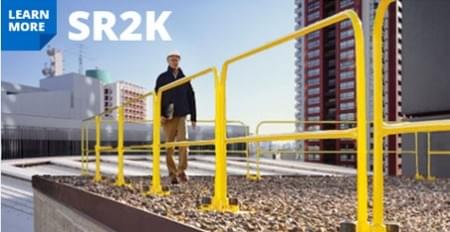To keep your workers safe—and comply with OSHA's fall protection guidelines—you must provide rooftop guardrails for crews working at elevations of six feet or more. Recognizing the necessity for fall protection systems is the first step towards workplace safety, but OSHA compliance requires extra diligence, in-depth knowledge, and preventative troubleshooting.
From years of experience with OSHA's regulations, we know that certain aspects of safety rails can present unforeseen challenges for safety managers. To help, we've compiled a list of the six most common mistakes we have seen. Additionally, we provide some actionable solutions to these common mistakes—and hope to help provide better protection for you, your workers, and your equipment.
Though you already know you need fall protection systems for rooftop safety, sifting through the fine print in OSHA's guidelines can be challenging. Because of the detailed requirements, we have seen many cases in which compliance was impacted by small errors. Here are some of the commonly missed or misunderstood fine points of fall protection systems, many of which can present an issue even if off by an inch:
As you can see, guidelines for OSHA guard rails are exacting and precise. One of the best solutions for catching all the fine print—down to the difference of a quarter inch—is to partner with a company that is intimately acquainted with the minutiae of OSHA regulations. Make sure that your safety rails are created with OSHA compliance in mind, so that you don't need to stress about the fine print.
When it comes to rooftop guardrails, it's important to take the specifics into account. Each roof has a different combination of factors, and it's easy to make mistakes by disregarding any of the following specifications:
Although most of the work on your structure will probably be done during daylight hours, it's important to have a system in place for extenuating circumstances. Under OSHA's general guidelines, it's pivotal to provide safe working conditions no matter the circumstances. If there's any possibility your workers will access rooftop areas in dusk or dim lighting, it's crucial to provide adequate lighting.
Choosing bright, steady lighting to highlight rooftop railings, gates, skylights, or hatches can provide a solution for dim lighting conditions. To save on energy, consider investing in solar-powered lights that will provide long-lasting light in dim (and therefore unsafe) conditions.
 Most mistakes regarding OSHA guard rails are completely preventable—yet unfortunately manage to create an expensive hassle for safety managers. One of the most common involves inadvertently using guardrails that damage the structural integrity of your roof. Though these can satisfy OSHA requirements, they also cause incredible damage to your rooftop's expensive membranes due to aggressive drilling techniques.
Most mistakes regarding OSHA guard rails are completely preventable—yet unfortunately manage to create an expensive hassle for safety managers. One of the most common involves inadvertently using guardrails that damage the structural integrity of your roof. Though these can satisfy OSHA requirements, they also cause incredible damage to your rooftop's expensive membranes due to aggressive drilling techniques.
Luckily, there is a painless alternative to damaging your roof with your fall protection system. Simply install non-penetrating guardrails. OSHA-compliant, non-penetrating guardrails do not require drilling. In fact, some non-penetrating systems require no tools whatsoever, and offer an incredibly streamlined and damage-free alternative. In addition, the physics of well-designed no-drill systems means that they can lock in place without the use of intermediate counterweights. This not only protects your roof, but also minimizes trip hazards for your employees.
As great and well-managed as your fall protection systems may be, they may not accomplish their purpose if workers aren't properly trained on operating or working around a guardrail system. In fact, proper training is an integral aspect of Workers' Rights as defined by OSHA. Each member of your team should receive training on, among other things, the following:
In addition, it's pivotal to train your employees on how to recognize and remove hazards in the workplace that would impact the efficacy of their safety rails. Help them to understand that inclement weather like snow or ice might create dangerous work conditions. As a safety manager, it's important to ensure that this safety information trickles down to the managers, supervisors, and crew on staff at any given time.
Installing safety rails requires a strong attention to detail. It's important to follow the included diagrams and instructions to the letter. Just a few simple issues or miscalculations can result in the entire system being dangerously askew or unreliable. Unfortunately, this can result in rooftop guardrails that are not only non-compliant to OSHA's standards—but aren't adequately protective of workers.
These mistakes can be prevented by a close and thorough understanding of installation instructions. Additionally, utilizing the services of a professional installation service can make all the difference. Professionals who are familiar with every aspect of OSHA guard rails will ensure a smooth, safe, and compliant system to protect your workers.
Every work space is unique, so to ensure compliance, your OSHA guard rails must be too. At Blue Water Manufacturing, we have years of experience adhering to OSHA guidelines and providing a safe work place for rooftop workers. Our expertise makes us specially equipped to recognize and prevent mistakes before they happen. If you're seeking professional input on fall protection— from non-penetrating guardrails, to solar safety lighting, to professional installation—please reach out to us today for more information.